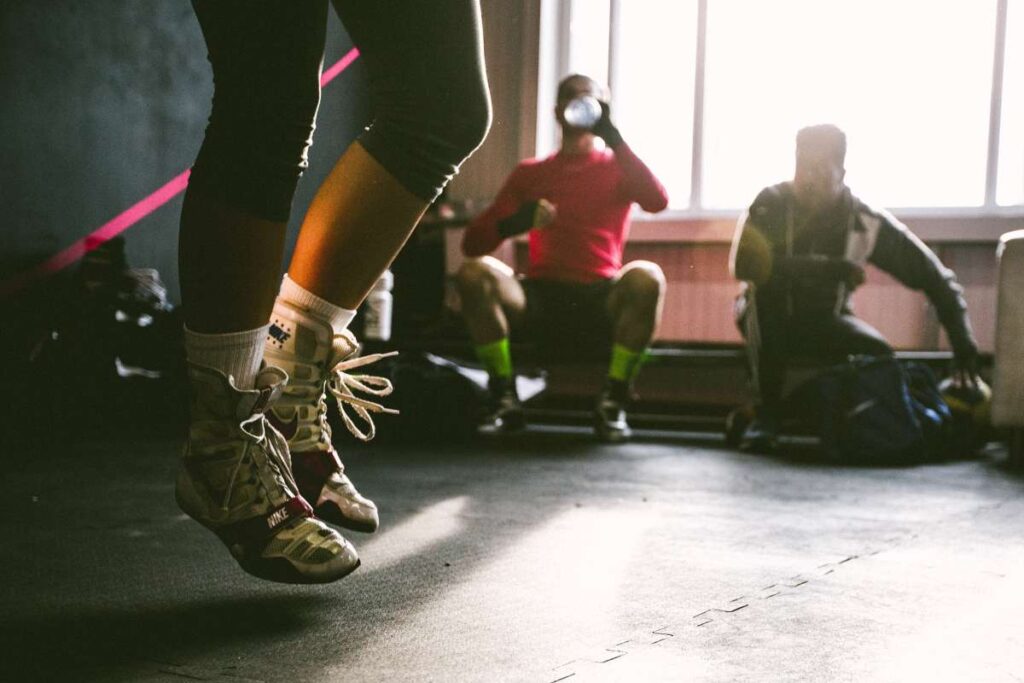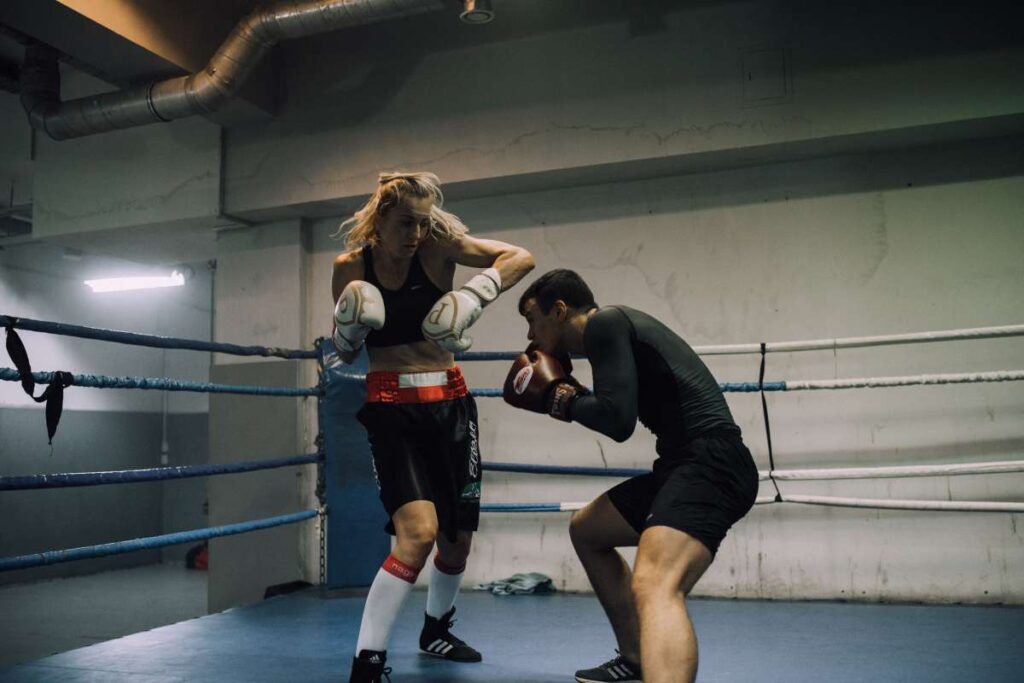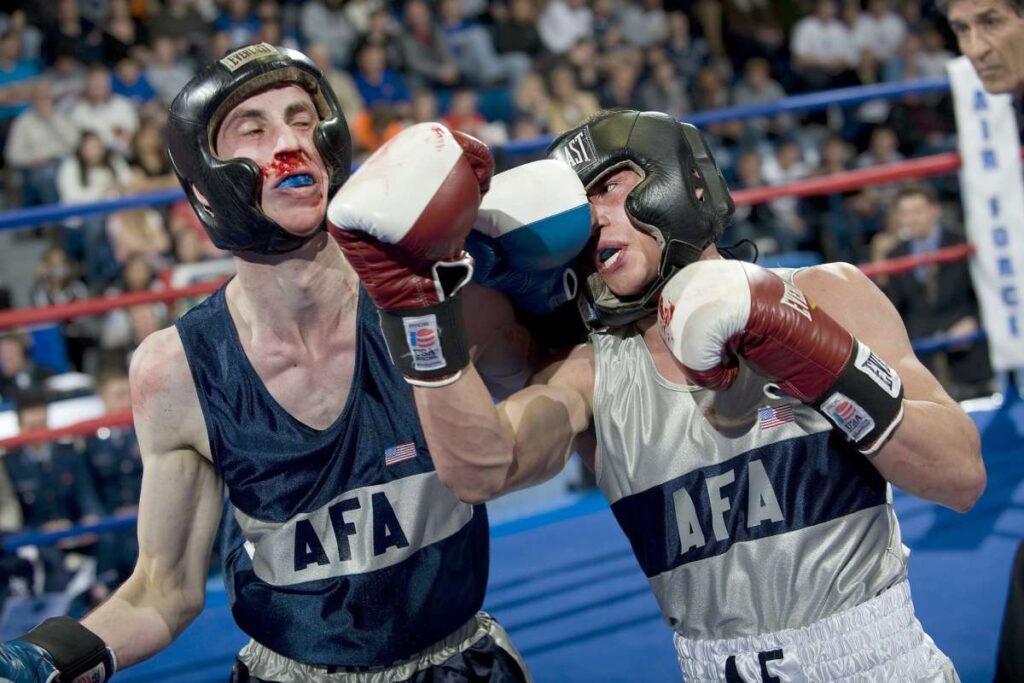The foundations of boxing are crucial to your growth as a fighter and athlete. It becomes much simpler to go on to the higher levels of your training once you have the fundamentals established.
His footwork is one facet of boxing that is frequently disregarded, especially in the early stages of training. Because it enables you to position yourself to deliver your combinations with the greatest possibility of connecting, footwork is crucial in boxing. You can also use it to get yourself out of danger when necessary.
A relaxed gait and unrestricted movement are signs of good footwork. You may move about the ring without thinking about it deliberately and with ease. Once you've developed a certain amount of footwork, moving about will come naturally.
Beginners in boxing or other martial arts sometimes just concentrate on honing their blows and pay little attention to their footwork. And that is a serious error. If you watch the top boxers, they almost seem to "dance" in the ring. And with good cause.
Your punches will land more forcefully and correctly if your boxing footwork is improved, but more significantly, you will avoid getting hit by your opponent. If it's bad, you may get knocked out soon from a big punch, and your punches wouldn't land where you wanted them to. Thus, honing your footwork is just as important as honing your punches.
FAQs
Footwork is the cornerstone of effective boxing training. Getting comfortable with proper stance and foot movement is key to advancing your boxing skills. The importance of good footwork in boxing cannot be overstated.
Unlike the basic “step-drag”, which is taught to beginners to help them stay grounded and save energy, the bounce step allows the fighter to change directions quickly and cover more distance, at the cost of using more energy.
One is taught the placement of the foot in throwing a punch to get the entire body into the punch. That placement can give the opponent from where the punch is coming. In Ali’s case, that notice would be futile, and the shuffle as is called was more to attract the opponent’s eye or attention.
Ali’s repertoire’s greatest and most important skill was his otherworldly footwork. Above all else, the Ali Shuffle was just Ali using his footwork to his advantage, offering him unusual evasive movement that confused most of his opponents and left them guessing.
This might come as a shock, but fast feet will not make you fast. Furthermore, the ability to move your feet quickly will not make you agile.
Why Is Footwork Important In Boxing?
“Float like a butterfly, sting like a bee.” – Muhammad Ali.
If ever there were a phrase or a scenario to illustrate the value of sound footwork in boxing, it would be this.
Perhaps the most neglected component of what it takes to be a great boxer is footwork. Fighters with excellent footwork frequently have a significant advantage over their flat-footed opponents, going all the way back to Sugar Ray Robinson to a master technical like Vasyl Lomachenko.
Boxing footwork aids combatants in maintaining balance, similar to your stance. Delivering powerful punch combinations, increasing accuracy with each strike, and preparing boxers for offensive moves are all essential as well.
The success of top boxers is sometimes attributed to their excellent footwork. In real-life fight situations, it is crucial to be able to manoeuvre around one's opponent while maintaining balance quickly. Fundamentals of boxing footwork must be learned if beginners want to advance their skills quickly.
Flashy antics by people like Naseem Hamed made them seem good in the spotlight and helped opponents become frustrated and perplexed. However, effective footwork is more than just that; it may win battles from the outside while taking little punishment. After all, why even bother shooting when you can move out of the way sufficiently to make your opponent punch into nothingness?
Additionally, good footwork can aid you offensively in a variety of ways, including closing gaps, slipping punches, and creating deft angles.
You can create quick and efficient motions in a variety of methods. There are several things, though, that you should be aware of because they can later cause you issues. Some essential elements will let you dominate your opponent, as Willie Pep allegedly did in 1946 when he defeated Jackie Graves, using only his jab and footwork to win the round.
What is good footwork in boxing?
Boxers with excellent footwork can easily move around and into their opponents' range. You can learn to move side to side, pivot, and go in and out of range after you practise your footwork, usually leaving your opponents unable to keep up.
What is footwork in fighting?
The phrase "footwork" refers to how one generally uses their legs and feet when engaged in stand-up combat. Footwork consists of:
- Keeping balance.
- Closing or furthering the distance.
- Controlling spatial positioning.
- Creating additional momentum for strikes.
The Keys To Learning Boxing Footwork
Boxing footwork basics are difficult to master and internalise. Working on drills that concentrate on the required movements is one of the most effective approaches to improve this process. Boxing footwork may be improved much more quickly with a concentrated strategy than by simply hoping for it to come together via frequent training.
Your footwork will be more fluid after practising these activities, and your calves and legs will create the rhythmic, reactive bounce needed for boxing. Stop and start changes in direction. Punching is incorporated into movement while you move, which is crucial for boxing.
Drill 1 – With a pendulum step, you will first practise the side-to-side lateral motion. It's crucial to move laterally to make oneself more difficult to strike and your attacks less predictable.
Drill 2 – To retain balance as you progress, you should get used to switching from lateral motion to forward and backward footwork and doing this on both sides.
Drill 3 – allows you to switch between movement and punching, and vice versa. This is crucial for escaping after throwing or pursuing a moving adversary. There are, of course, more sophisticated and strategic ways to accomplish this. Here, we're practising a simple drill.
Boxing Footwork Drills For Beginners
The simplest balance and footwork exercises for boxing. Important for all combatants!
Are you a boxer who is just starting out and attempting to improve your fighting footwork, or are you an experienced fighter trying to make your footwork rock-solid?
Here are a few basic exercises that I believe every fighter has to know! It's relatively easy, but it cannot be easy for skilled fighters or physically fit people.
While those outside the sport may believe that punching your opponents with your arms is the most crucial ability, any professional boxer will tell you that controlling the ring is all about your footwork. It all comes down to having the proper foot movements when you consider how important it is to move around in order to avoid punches and deliver a punch with force. So allow us to walk you through the fundamentals of footwork so you may improve as a boxer.
Why Bother With Boxing Footwork Training?
Although the hands are the main focus in boxing, footwork is an essential and frequently disregarded aspect of the sport.
You must be able to enter and exit striking range when fighting quickly.
You can control the fight's tempo if you can think on your feet quickly. You have three options: slow it down and take your time with your bullets, push your adversary into the corner, or move quickly and evasively like a "ghost" who is never far away.
Additionally, a lot of your force comes from your feet and legs because your upper body strength can only carry you so far.
To get knockout hooks, you must pivot on the balls of your feet. Additionally, powerful crosses and uppercuts can be delivered when you are able to push off the ground and transmit the force from your legs.
Your ability to respond quickly, move with more agility, and maintain balance in battle will all be improved by performing exercises that target the fast-twitch muscles in your legs.
FOOTWORK DRILL 1 – SLIP > PIVOT
To avoid a right hand, start in a traditional boxing posture and move your head to the left. As you rotate clockwise around your front foot and bring your back foot around behind you, bring your head back to the centre. This should cause a 90-degree change in your stance. While slipping to the left and finishing with your hands up, protect your jaw at the end of the action by keeping your right hand raised the entire time.
FOOTWORK DRILL 2 – STEP + SLIP > PIVOT
Resuming your traditional boxing stance, move your head to the left to avoid the imagined right strike. Step your lead foot to the left concurrently as you stumble this time. This small action allows you to distance yourself from an opponent and have more room to deliver punches. Finish by pivoting in the same manner as in footwork drill one and rotating 90 degrees counterclockwise.
FOOTWORK DRILL 3 – STEP + SLIP > HOOK + PIVOT
Only this time, this exercise is the same as footwork exercise 2. You'll pivot clockwise and throw a left hook. You might want to practise throwing hooks and straight left punches as you will need to adjust your punch depending on what your opponent does. However, don't let this worry you too much. Once more, we are honing our balance and footwork since good footwork makes it simple to adapt punches.
FOOTWORK DRILL 4 STEP + SLIP > HOOK + PIVOT > CROSS
In the last exercise, you will add a straight right punch at the finish of the footwork drill 3 sequence. The pivot you make during the hook will position your shoulders for a straight right hand and enable you to make your right foot do plyometric exercises. By lifting off the ground and shifting your weight back through the punch, this plyometric effect can assist you in producing power with the right cross. If you find it difficult to maintain balance, step your right foot up underneath you as the punch is delivered to help prevent you from slipping forwards.
Boxing Footwork – Moving In And Out
Unsurprisingly, boxing footwork entails using the feet to move in specific directions. Going forwards and backwards, more frequently known as "moving in and out," is one of these movements. To get in and out of range, boxers use some physically straightforward movements in their footwork.
Understanding your position in relation to your opponent — which we refer to as "range" — is crucial to success in boxing. A boxer can decide up front whether they will be "in range" or "out of range" for their shots to land on them as well as their opponent's. This can be further divided into short, medium, and long-range once the boxer is in range. Visit the article on boxing range findings to learn more about the range.
After discussing range, it is important to realise that being "on the edge of the range," or just out of your opponent's punching range, is essential for success in boxing. This implies that the boxer is able to go out again before the opponent's inevitable response with a quick, explosive movement of the feet to close the distance and score effective shots. One way to put pressure on an opponent and gain control of the battle is to be on the edge of the field while posing a mobility threat.
The Mechanics of Moving In and Out
Moving In
Procedures for moving in:
From a boxing stance, the first move is a push with the rear foot.
The front foot rises a little bit off the ground, which gives the body's push from the rear foot enough force to move the front foot forwards.
Permit the back foot to advance until it meets the front foot.
The boxer should maintain his or her posture the entire time, and the movement should only extend 6 to 8 centimetres.
Moving Out
Moving away works like this (unsurprisingly, it's the complete reverse of moving forwards!):
The opening move is a push from the front foot while in a boxing stance.
The front foot's force can drive the body and, consequently, the back foot forwards when the rear foot lifts a little bit off the ground.
Permit the front foot to take its natural course and catch up to the back foot.
The boxer should maintain his or her posture the entire time, and the movement should only extend 6 to 8 centimetres.
Footwork Techniques
SHUFFLING
To be agile and, as they say, "always on your toes," use the shuffling technique as your main technique. You can get ready for quick movements in either direction as needed by quickly alternating your feet and keeping your weight on the balls of your feet.
SLIDING
The slide is a crucial motion that enables you to quickly and forcefully deliver a punch or to retreat from an approaching blow quickly. When it's time to cast a strike or advance in a specific direction, step with the foot that will be leading. Use the shuffle as your platform. Drag will cause resistance and slow you down, so avoid it.
PIVOTING
The pivot is crucial when you need to turn your body in a different direction. You keep your front foot firmly planted on the ground, similar to a pivot in basketball or netball and rotate your body around that foot. This technique comes in handy when you don't have enough time to move back or forth but still need to dodge an incoming strike or throw one of your own. Pro tip: If you can predict an impending strike, this is the ideal manoeuvre to rapidly evade and hurl your own strike from an angel against a susceptible target.
NARROW STANCE
A narrower stance gives you a better opportunity of moving around than a broad one.
Keep your knees slightly bent and your feet spaced about shoulder-width apart so that you can quickly spring into action.
BALLS OF YOUR FEET
Your toes and arch meet at the balls of your feet.
This method is necessary for greater agility in several sports.
SMALL STEPS
Most of the time, little steps prevail over big strides.
When you close the distance after injuring your opponent, take large strides.
You can correct your angles, maintain your balance, and increase consistency by taking small internal steps.
WEIGHT DISTRIBUTION
Bodyweight in the front is positioned to facilitate slipping and dipping. Lean backs and shoulder rolls are made possible by the rear body weight.
The finest of both worlds is yours if you maintain a healthy weight in the centre.
CONNECT HANDS TO FEET
You step using the opposing arm to swing forwards instead of walking, which uses a natural swing to build momentum.
Keep your arms rigidly raised and positioned about your face to protect yourself when boxing.
In this sport, there will be no counterbalancing when using footwork. As a result, you wish to be safe.


